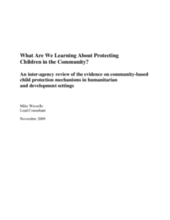Community-based child protection mechanisms are at the forefront of efforts to address child protection in emergency, transitional, and development contexts worldwide. The mobilization of such grassroots groups has become a common programming response in many settings, particularly in areas affected by armed conflict or displacement. For international agencies, they are a favoured approach in places where local and national government is unable or unwilling to fulfill children’s rights to care and protection.
These groups are a vital means of mobilizing communities around children’s protection and wellbeing. Organised with care and in a contextually appropriate manner, they make it possible to: identify, prevent and respond to significant child protection risks; mobilise communities around child protection issues; and provide a base of local support and action that can be taken to scale through links with other community groups and with national child protection systems. These national systems include more formal, governmental mechanisms and also less formal, civil society mechanisms, such as traditional justice systems.
Although this approach is widely used and supported by international agencies, there is at present a lack of robust evidence about the effectiveness, cost, scalability and sustainability of community-based child protection mechanisms. This lack of systematic evidence impedes accountability and makes it very difficult to define effective practices, develop appropriate inter-agency guidance for practitioners, and harmonise and strengthen the quality of practice. The lack of systematic evidence also impedes efforts to obtain the funding needed to support children’s protection and wellbeing, advocate effectively for increased investment by governments in child protection systems, and encourage policy leaders to promote the most effective practices and policies.
To address this evidence gap, a number of child protection agencies came together to conduct a review of the available global evidence on community-based child protection mechanisms and their impact on children’s protection and wellbeing. The review is the first part of a two-phase process and raises key questions that will be pursued in the field research that will form part of phase two.
The full report presents the findings and methodology in greater detail, analyses more fully key issues and challenges, discusses a greater variety of case studies and models of promising practice, and explores the implications for national child protection systems.
Annexed to the full report, is also a full set of descriptions and analysis of each of the documents reviewed according to a standardised matrix. The full report is included in the CD ROM attached and is also available at www.savethechildren.org.uk/onlinelibrary.

